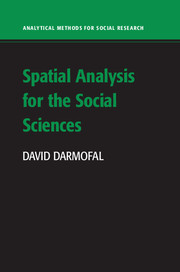Book contents
- Frontmatter
- Contents
- List of Figures
- List of Tables
- Preface
- PART I GENERAL TOPICS
- 1 The Social Sciences and Spatial Analysis
- 2 Defining Neighbors via a Spatial Weights Matrix
- 3 Spatial Autocorrelation and Statistical Inference
- 4 Diagnosing Spatial Dependence
- 5 Diagnosing Spatial Dependence in the Presence of Covariates
- 6 Spatial Lag and Spatial Error Models
- 7 Spatial Heterogeneity
- PART II ADVANCED TOPICS
- PART III APPENDICES ON IMPLEMENTING SPATIAL ANALYSES
- Glossary
- Bibliography
- Index
5 - Diagnosing Spatial Dependence in the Presence of Covariates
from PART I - GENERAL TOPICS
Published online by Cambridge University Press: 05 November 2015
- Frontmatter
- Contents
- List of Figures
- List of Tables
- Preface
- PART I GENERAL TOPICS
- 1 The Social Sciences and Spatial Analysis
- 2 Defining Neighbors via a Spatial Weights Matrix
- 3 Spatial Autocorrelation and Statistical Inference
- 4 Diagnosing Spatial Dependence
- 5 Diagnosing Spatial Dependence in the Presence of Covariates
- 6 Spatial Lag and Spatial Error Models
- 7 Spatial Heterogeneity
- PART II ADVANCED TOPICS
- PART III APPENDICES ON IMPLEMENTING SPATIAL ANALYSES
- Glossary
- Bibliography
- Index
Summary
When employing the spatial diagnostics examined in Chapter 4, social scientists will often find evidence of spatial autocorrelation (see, e.g., Eff 2004). As discussed in Chapter 1, this predisposition of social science data toward spatial autocorrelation often results from interdependence between the units studied by social scientists. In other cases, social science data exhibit spatial dependence not as a result of behavioral interdependence but as a consequence of spatial clustering in the sources of behaviors of interest to social scientists. The spatial dependence, in short, may be consistent with either a spatial lag model or a spatial error model.
Substantive theory will often lead scholars to believe that a spatial lag specification or a spatial error specification is more appropriate for their particular substantive application. Scholars may, for example, expect that a spatial diffusion process is at work and thus believe that a spatial lag model is warranted. Although such a specification may seem appropriate, such a theoretical expectation should not go untested. It would be inappropriate to estimate a diffusion model with a spatially lagged dependent variable if the spatial dependence diagnosed via, for example, the univariate Moran's I, is instead produced by spatial clustering in the sources of otherwise independent behaviors. This model misspecification will lead the researcher to inappropriate substantive inferences about the nature of the spatial dependence in her data.
Inappropriate spatial model specification is all the more problematic because of the close mathematical relationship between a spatial lag model and a spatial error model with spatial autoregressive error dependence. As this chapter will discuss, a spatial autoregressive error model can be rewritten as a spatial Durbin model with both spatially lagged dependent and independent variables if a set of nonlinear common factor constraints are valid. Because of this close relationship between spatial autoregressive dependence in a spatial lag model and spatial autoregressive dependence in a spatial error model, a significant spatial parameter in a spatial lag model may reflect spatial clustering in omitted sources of the behavior of interest rather than true spatial lag dependence consistent with a diffusion process.
- Type
- Chapter
- Information
- Spatial Analysis for the Social Sciences , pp. 68 - 95Publisher: Cambridge University PressPrint publication year: 2015

